6 Stunning Must-Visit Destinations in Kazakhstan
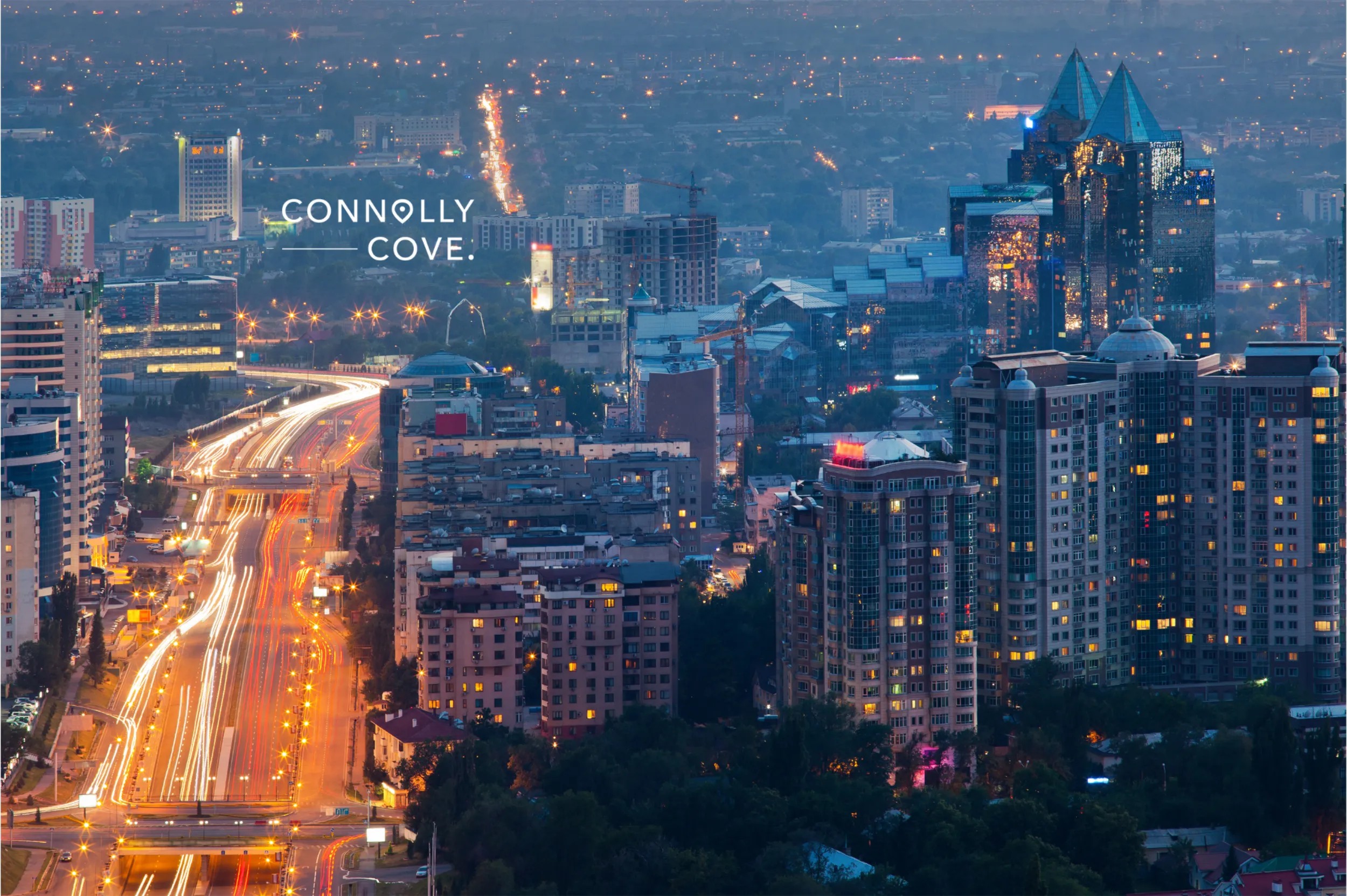
Updated On: April 17, 2024 by Raghda Elsabbagh
Today, we’re journeying to one of the world’s best-kept secrets, Kazakhstan. From the sweeping Altai Mountains in the East to the enchanting shores of the Caspian Sea in the West, Kazakhstan is the biggest landlocked country on the planet and the ninth-largest country in the world. We’re talking big, so big that it throws in five climate zones and two time zones just to keep you on your toes. The fun part is that even though Kazakhstan is one of the world’s ten largest countries, it’s still the hidden gem of the travel world. It’s still not on many folks’ bucket lists, which means you get to explore those hidden treasures without the crowds.
Now, what’s on Kazakhstan’s menu, you ask? Well, how about majestic canyons that’ll leave you in jaw-dropping awe, deserts as endless as your Aunt Mildred’s stories, and plains so arid they make a desert seem like a water park? And guess what? It’s not just empty land; it’s rich with oil and gas, making it the wealthiest kid on the block in the region. This place is a year-round adventure. But don’t just take our word for it; Kazakhstan is a subdued vacation paradise just waiting for you to scribble it on your bucket list.
So, if you’re an adventurous traveller up for cool and unusual destinations, grab your map, backpack, and sense of adventure; Kazakhstan is calling your name, and it’s a date you won’t want to miss. Let’s explore the best destinations in this Central Asian gem together!
A Glimpse into the History of Kazakhstan
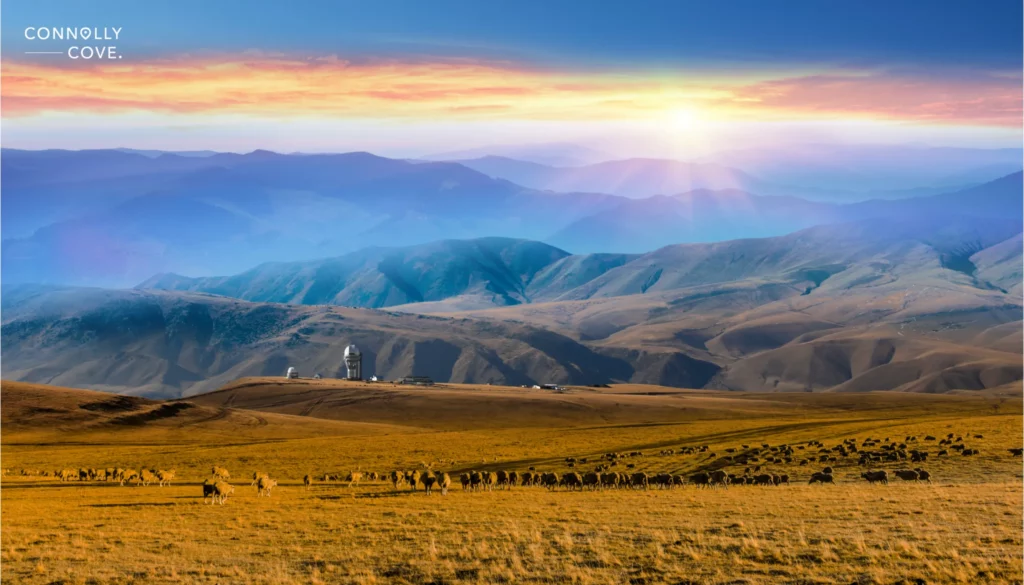
Kazakhstan boasts a rich and varied ancient history, with archaeological evidence pointing to human habitation dating back thousands of years. The region was once home to nomadic tribes, including the Scythians and Saka, who thrived in the vast steppes and arid landscapes.
The Scythians and Saka Tribes
These nomadic cultures played a crucial role in shaping the identity of the land now known as Kazakhstan. The Scythians, in particular, were known for their fantastic metalwork and knack for creating intricate art and burial mounds, leaving a lasting archaeological legacy that has captured the fascination of historians and archaeologists. Their work practically shouted, “We were here!” They wanted to make sure history buffs would have plenty of stuff to dig up later!
Influence of the Silk Road
The geographical location of Kazakhstan also placed it at a strategic crossroads, thanks to the influence of the Silk Road — not the shiny, paved kind, but a network of trade routes connecting the East and West. Kazakhstan was a pivotal point along this ancient path, and traders and travellers made it their pit stop. They brought goods, ideas, religions, and stories that wove their way into Kazakhstan’s culture, leaving it with a flavourful blend of influences.
The Mongol Empire and its Impact
Fast forward to the 13th century, the Mongol Empire, led by Genghis Khan and his descendants, swept through the Eurasian continent, leaving few regions untouched. Kazakhstan was no exception, as it came under Mongol rule. The Mongols imparted a profound impact on the region, not only through their military conquests but also through the Silk Road trade connections they maintained. During their rule, they promoted economic exchanges, cultural interactions, and the spread of ideas throughout their vast empire. Suddenly, Kazakhstan was the place to be for all things international.
The Kazakh Khanate
The Kazakh Khanate emerged in the 15th century as a significant power in the region. Under the leadership of various Khans, this entity brought together the nomadic tribes of the area, fostering a sense of unity among the Kazakh people. The Kazakh Khanate played a crucial role in keeping the peace, resisting external threats, and maintaining relative autonomy, all while preserving the nomadic way of life that had long been central to the Kazakh identity.
Russian Colonisation and Soviet Rule
With the arrival of Russian colonists, the 19th century witnessed a significant transformation in the history of Kazakhstan. They showed up like that unexpected guest at a party. By the late 19th century, the Russian Empire had extended its dominion over the vast Kazakh territories. They said, “Hey, Kazakhstan, we’re moving in!” The Russian colonisation introduced a new political and economic order. They disrupted the Kazakh’s traditional nomadic way of life and built up tension within the region.
In the 20th century, Kazakhstan became an integral part of the Soviet Union. Soviet rule drastically altered the socio-political landscape, leading to agricultural collectivisation, the suppression of traditional customs, and mass deportations of various ethnic groups, including the Kazakhs, to Central Asia.
Independence in the 20th Century
Now, here comes the most exciting part of the story — the 20th century and the journey to independence! And what a turbulent journey it was. The collapse of the Soviet Union in 1991 marked a turning point, as Kazakhstan declared its sovereignty and gained independence. Nursultan Nazarbayev, the First Secretary of the Communist Party of the Kazakh Soviet Socialist Republic, became the country’s first President and guided Kazakhstan through the challenging transition to statehood.
This period marked a new beginning in the history of Kazakhstan, with a focus on building the nation, growing the economy, and preserving its cultural heritage. And that, my friend, is the story of Kazakhstan — from ancient tribes to Soviet colonisation to the spirited path to independence.
Kazakhstan’s Geography
Journeying through Kazakhstan’s geography is like flipping through a breathtaking photo album. You’ve got vast steppes and wide-open green spaces that seem to go on to infinity.
Move on to the deserts, and you’re suddenly in a different world — a sandy, golden one, but not the beachy, cocktail-in-hand kind. This is more like a “survival mode on” setting, with scorching days and bone-chilling nights. You’d better bring sunscreen and a parka!
If you’re in the mood for mountain adventures, head to the eastern part of Kazakhstan, where you’ll find the majestic Tian Shan Mountains. They’re the country’s crowning jewel, with snowy peaks, lush valleys, and rugged terrain that will leave you feeling like Indiana Jones on a mission.
Environmental Challenges and Conservation Efforts
Yet, there’s a catch — with such diverse landscapes and natural beauty comes the challenge of environmental conservation. From the Caspian Sea’s fragile ecosystem to preserving the unique steppe habitats, Kazakhstan has its hands full. But they’re not shying away from the challenge; tremendous conservation efforts are made to protect the country’s natural beauty.
Ethnic Diversity in Kazakhstan
Kazakhstan is like Central Asia’s “United Nations” regarding ethnic diversity. You’ve got Kazakhs, the largest ethnic group making up much of the population, Russians, Uzbeks, Ukrainians, and a whole bunch of other ethnic groups living together. It’s like a cultural potluck where everyone brings a unique dish to the table. So, in Kazakhstan, you’ll hear different languages, see people celebrating various holidays, and taste many delicious cuisines. This diversity is a source of strength, making Kazakhstan rich in traditions, languages, and cultural tapestry.
Kazakh Traditions and Customs
Kazakhstan’s culture is like a beautifully woven tapestry, with traditions and customs that add colour to everyday life.
Celebrations and Festivals
Kazakhstan’s cultural scene is a big, never-ending party! They’ve got celebrations and festivals for every occasion, from Nauryz Meyrami, their own New Year’s Eve shindig, to their version of the ultimate neighbourhood barbecue. These folks just know how to have a good time.
Traditional Clothing
Traditional clothing? Well, they don’t mess around when it comes to dressing up. Kazakh outfits are works of art — men in dashing dombra robes and women in dazzling dresses, often decorated with intricate patterns. It’s like they’ve got the red carpet rolled out for daily life.
Cuisine
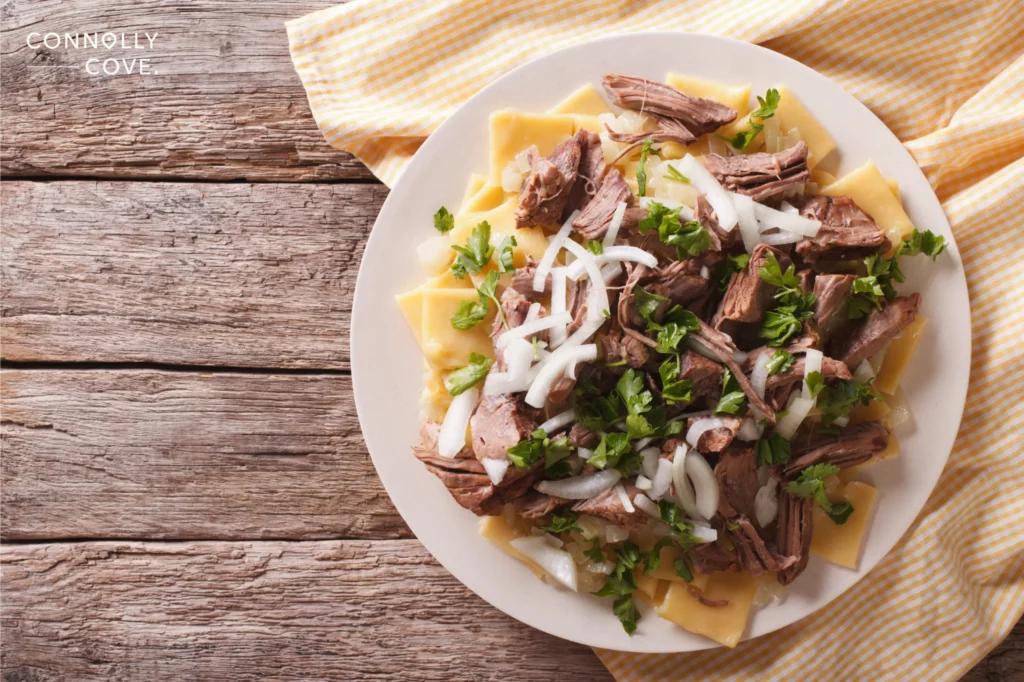
Let’s talk food — because isn’t that the heart of any great gathering? You’ve got beshbarmak, which means “five fingers” because you’re supposed to eat it with your hands — and it’s finger-licking good. And plov, a hearty rice dish that’s the party animal of their cuisine, and you don’t want to miss the feast!
Nomadic Heritage Preservation in Contemporary Culture
You know how some folks are nostalgic for the good old days? Well, Kazakhstan isn’t just nostalgic; they’re keeping those good old days alive. Their nomadic roots are still preserved and are actually the foundation of their modern culture — like a family album they never want to forget or an ancient family recipe they still use.
And these nomadic vibes? They’re everywhere, influencing everything; it’s the secret sauce in their modern culture. Take art, for example. Kazakh art is like a mirror reflecting their nomadic heritage. Everything encapsulates history in a modern package, from intricate feltwork to vibrant tapestries.
Lifestyle, too, has a nomadic twist. Yurts, those portable homes, are still used today, and it’s like camping with style. They’ve got the best of both worlds — modern comfort with a touch of nomadic nostalgia.
Language
The main languages spoken in Kazakhstan are Kazakh and Russian. The Kazakh language is like a song you can’t get out of your head — beautiful, captivating, and with a unique rhythm. They love it so much that it’s their official language, and they even have their own fancy Cyrillic alphabet to make it extra special.
Best Destinations in Kazakhstan
Often overshadowed by its more famous neighbours, Kazakhstan is a canvas of breathtaking destinations that are an adventure to the soul.
1. Almaty: The Cultural Capital
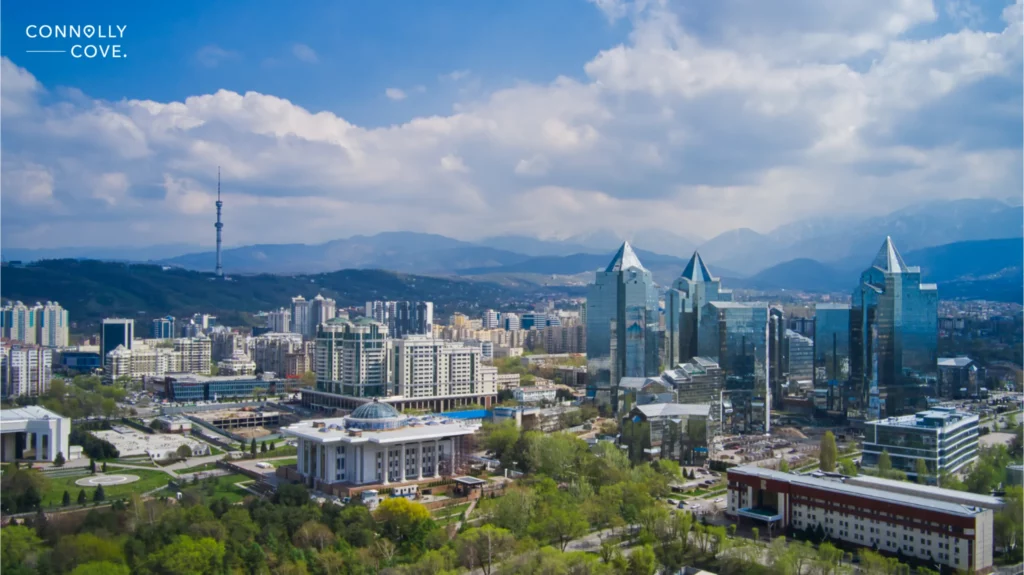
Our journey kicks off in Almaty, Kazakhstan’s cultural darling and largest city. Almaty, the former capital, is nestled in the foothills of the Tian Shan Mountains, welcoming visitors with a stunning blend of nature and urban life. Almaty is the Paris of Central Asia; it is all about style and sophistication. It’s that cosmopolitan friend who knows all the best spots in town, fancy restaurants, and chic boutiques.
Almaty’s historic charm is like a warm hug from your grandma. You can explore the Ascension Cathedral, an architectural masterpiece that makes other buildings blush. It’s common to see couples taking wedding photos near this magnificent building, adding a romantic touch to Almaty’s atmosphere.
Dig into the traditional Kazakh dishes like beshbarmak and shashlik, and don’t forget to hit the bazaars, where the tantalising aroma of spices and the vibrant colours of fruits and vegetables turn grocery shopping into a feast for your senses.
2. Nur-Sultan: The Modern Marvel
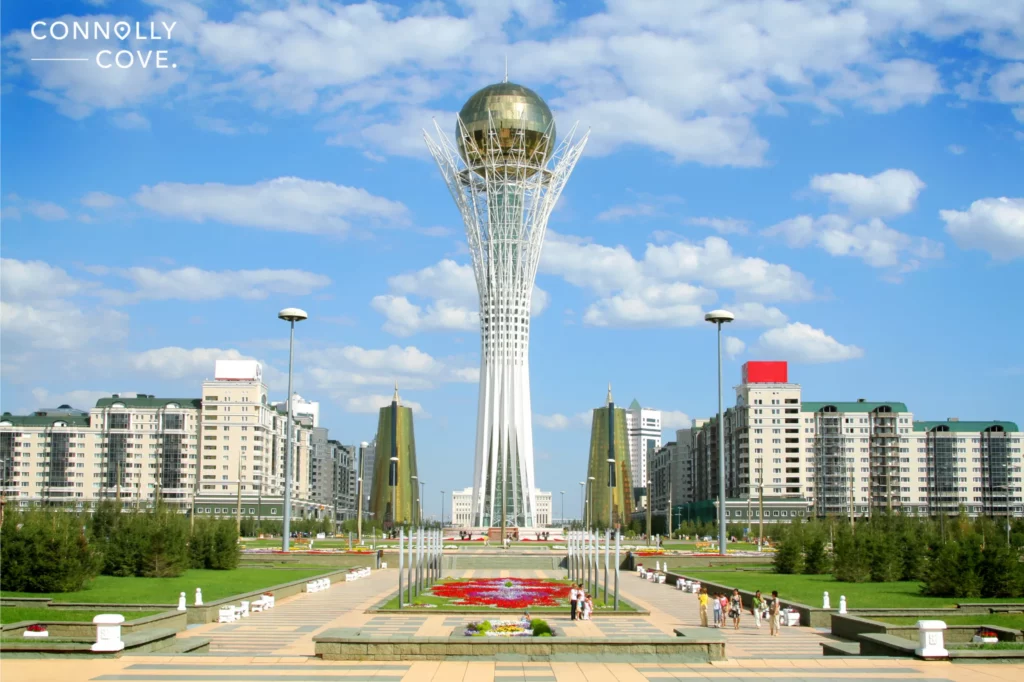
From the cultural heart of Almaty, we travel to Kazakhstan’s modern marvel, Nur-Sultan, the new kid on the block, formerly known as Astana. Nur-Sultan was renamed in honour of Nursultan Nazarbayev, Kazakhstan’s founding President.
It’s the capital now, and boy, has it transformed itself! Nur-Sultan is like a time-travel machine to the future; it’s all about futuristic architecture, grand government buildings, and modernity. It’s the kind of place where you’ll see skyscrapers and contemporary art installations at every turn. The iconic Bayterek Tower, a symbol of the city’s ambition, is like the Eiffel Tower‘s cool cousin, standing tall and shiny, saying, “Hey there, come and check me out!”
You’ll find cultural gems, too, like the Palace of Peace and Reconciliation, designed by Norman Foster. It’s like a spaceship landed in the middle of the city, ready to take you on a journey of artistic wonder. Don’t miss the Khan Shatyr Entertainment Center. It resembles a giant circus tent that houses a shopping mall, dining, an indoor park, and even a beach resort under its massive canopy. The city’s commitment to the arts is also evident at the Astana Opera House, where performances showcase the richness of Kazakhstan’s cultural heritage.
3. Charyn Canyon: A Natural Wonder
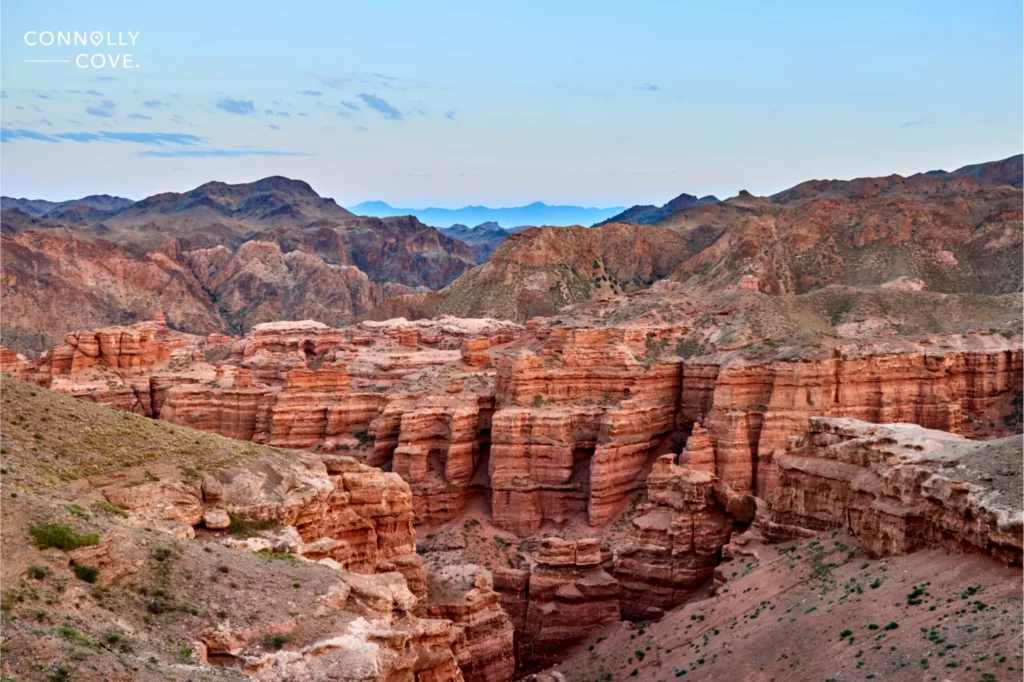
For those seeking a natural wonder, Charyn Canyon is a must-visit destination. Often compared to the Grand Canyon in the United States, Charyn Canyon offers a unique, rugged beauty of its own. The dramatic rock formations, sculpted by the Charyn River, create a surreal and otherworldly landscape. It’s nature’s version of abstract art.
If you’re into adventure, hike through the canyons, explore narrow passages, and discover hidden gorges. The journey to the “Valley of Castles,” with its tall, intricate rock formations, is a fabulous expedition if you’re a nature lover or a photographer.
And here’s the twist — Charyn Canyon is not just eye candy. It’s also an ecological wonderland. The region is home to diverse flora and fauna, making it Noah’s Ark of biodiversity. Tremendous efforts are underway to preserve this unique ecosystem so that you can always come to connect with nature and appreciate the beauty of Kazakhstan’s wild side.
4. The Silk Road Cities
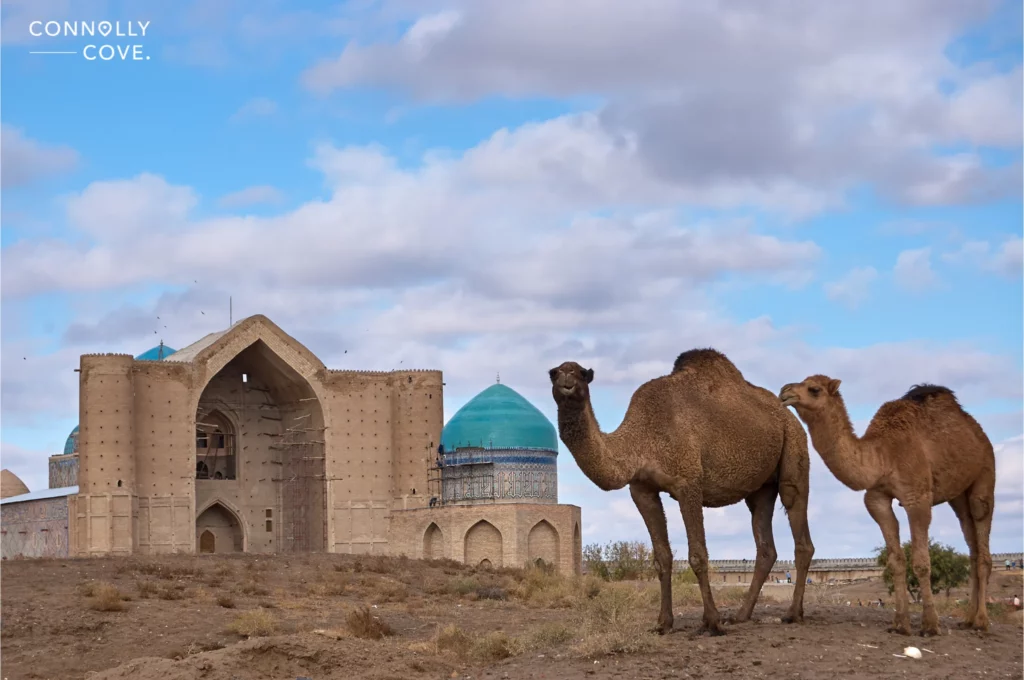
Kazakhstan’s history is closely intertwined with the Silk Road, an ancient trade route that connected the East and West. You can visit the Silk Road cities of Shymkent, Turkestan, and Taraz to explore this rich heritage.
Shymkent, the largest city in southern Kazakhstan, offers a vibrant blend of tradition, modernity and a good dose of history that you can witness at the Abay Museum.
Turkestan is where you’ll find the magnificent mausoleum of Khodja Ahmet Yasawi, a UNESCO World Heritage site. This remarkable site is a tribute to the Sufi poet and philosopher Khoja Ahmed Yasawi. With its stunning architecture featuring intricate tilework, artistic details, and spiritual significance, the mausoleum is a testament to Kazakhstan’s deep-rooted Sufi traditions.
Taraz, one of Kazakhstan’s oldest cities, boasts ancient ruins, historical sites, and a rich blend of cultures. Its historical significance as a melting pot of various civilisations can be seen in the remains of the Aisha Bibi mausoleum and the Babaji Khatun mausoleum.
5. Lake Issyk-Kul: Kazakhstan’s Blue Jewel
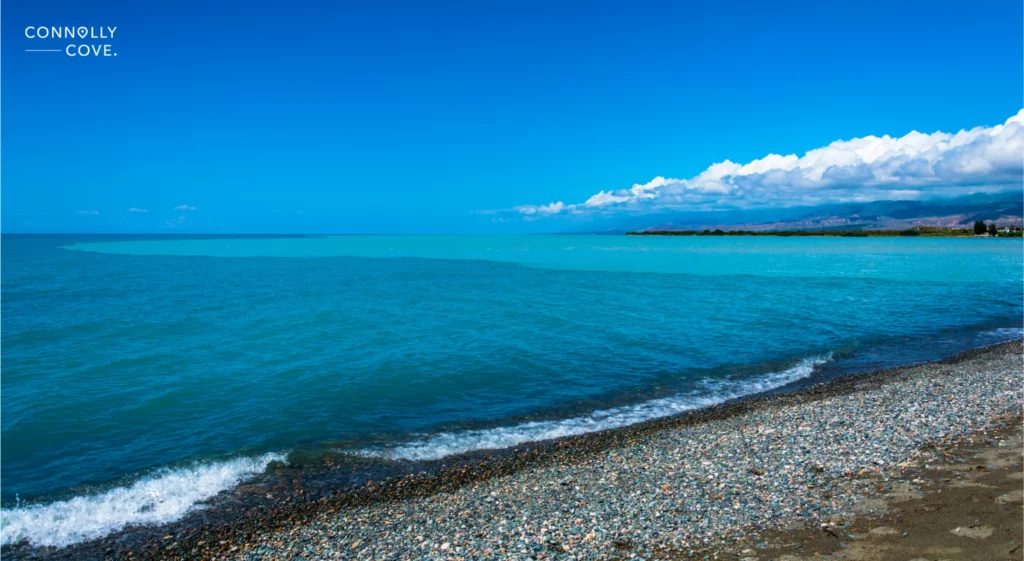
Lake Issyk-Kul, nestled in the Tian Shan Mountains, is often called Kazakhstan’s “Blue Jewel.” This second-largest alpine lake in the world is surrounded by lush greenery and snow-capped peaks, offering a tranquil retreat for visitors. The water is so clear you can see your reflection, and the mountains hug you warmly. It’s not just about sitting by the shore and watching the world go by, although that’s a great option. You can go swimming, jet skiing, yachting, or hiking to pristine mountain lakes and hidden waterfalls. It’s a paradise for nature lovers!
Remember to visit the Grigoryevskoye and Semenovskoye gorges, where you’ll feel like you’re walking through a postcard. If you’re into ancient history, the Cholpon-Ata petroglyphs, showcasing over 2,000 rock engravings, are a window to the past.
6. The Caspian Sea Coast
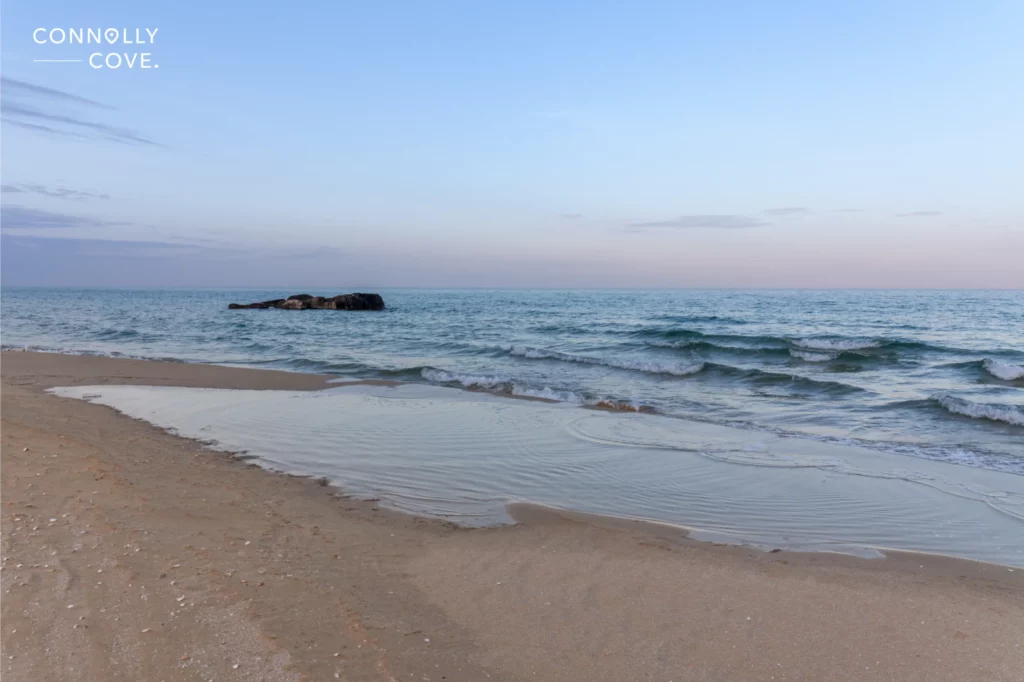
Last but not least, let’s hit the shores of the Caspian Sea, the planet’s largest inland water body, extending over 1,700 kilometres. Kazakhstan’s Caspian Sea coast is like a never-ending summer vacation.
The region is dotted with beach resorts, port cities, and diverse ecosystems. It’s a giant waterpark for water sports enthusiasts. You can sail, windsurf, fish, or just chill on the sandy beaches with a cocktail in hand to watch the picturesque sunset.
But it’s not just about fun and games. The Caspian Sea is like Kazakhstan’s cash cow, serving as a vital route for oil and gas exports. Its rich marine life and unique habitats add to the region’s ecological importance.
From the breadbasket in the north to the oil-rich west and the historic south, Kazakhstan’s cities are rich in distinctive flavours, traditions, and landscapes, ensuring you never get bored of this diverse nation. Kazakhstan is waiting, ready to surprise you with more hidden gems than you can imagine! So, are you prepared to embark on this epic adventure?






